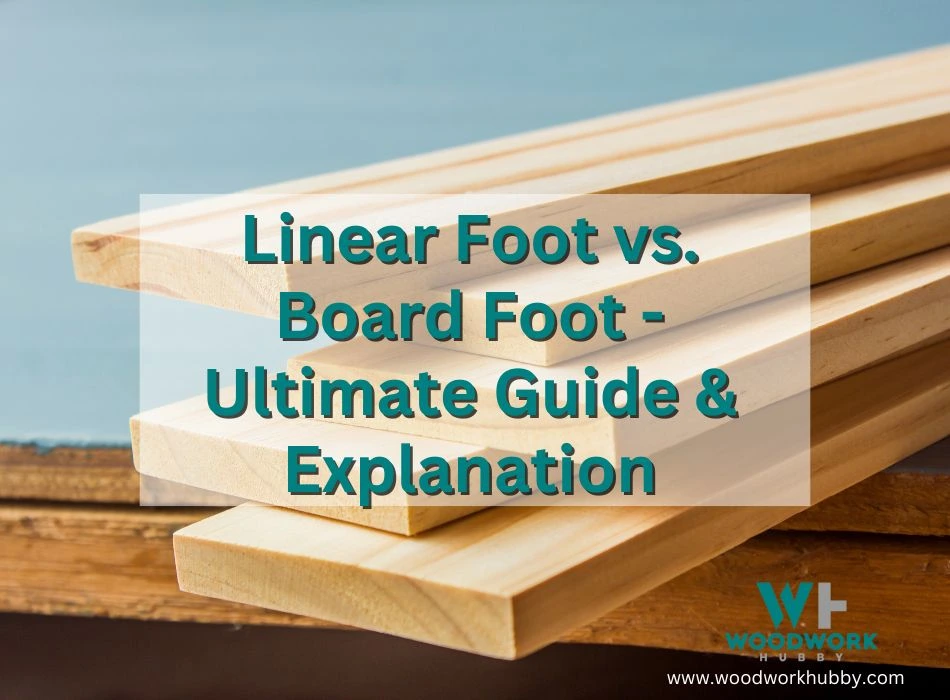If you have browsed prices of lumber online or sought quotes from wood suppliers, you might have heard the term “Board feet” thrown around. This can seem very confusing, especially if you are buying logs and not boards. And even if you’re buying boards, you might wonder which length the “board” foot and “linear” foot refer to.
A linear foot is used to measure the length of one side of a wooden board, while a board foot is used to measure volume when you multiply the length and width in feet, with thickness in inches. A board foot is typically 12 inches long x 12 inches wide x 1 inch thick.
In this article, you will learn why board feet are used in lumber pricing and how they can help produce a standard for sizing where linear feet fall short. You will also discover ten differences between linear feet and board feet and two ways to calculate board feet alongside a board foot calculator.
See further down this article for our board foot calculator.
Linear Foot: A Brief Overview
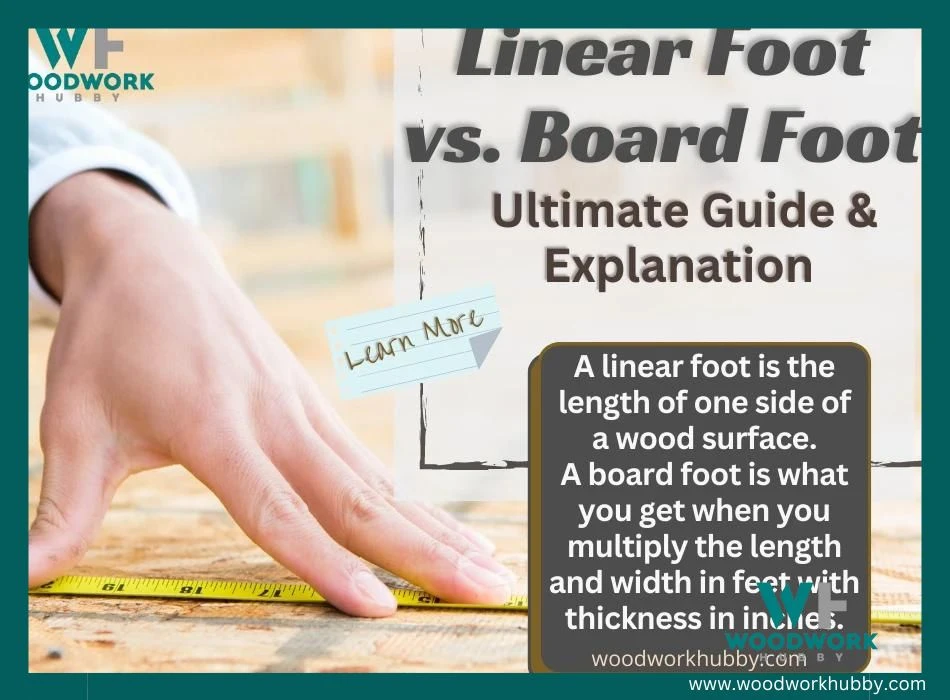
Let’s start with a brief look at feet. Not the ones you walk with but the ones you use to measure the length of your walk. A foot is a unit of length equal to 12 inches (30.48 centimeters). But there are plenty of things that can be 12 inches long. Your tablet computer can be 12 inches long, as can a subway sandwich. But they aren’t equal in size.
That’s because they don’t measure width and depth. The solution to this, for the most part, is to calculate volume. The width, depth, and breadth of wood measured in inches lead to the volume in cubic feet.
But in woodworking and lumber selection, the needs of measurement are slightly different. If the orders are made in volume, the selling party doesn’t know whether what’s required is a long and lean board or a short and thick one.
The following pieces of wood have the same volume:
| Length | Width | Depth |
|---|---|---|
| 10 | 10 | 2 |
| 20 | 5 | 2 |
| 20 | 10 | 1 |
| 50 | 4 | 1 |
| 100 | 2 | 1 |
| 200 | 1 | 1 |
| 20 | 4 | 2.5 |
You can see why ordering something based on cubic feet derived from linear feet would be problematic in the woodworking and construction industries. Board feet came about as a standardizing solution.
But before we get into board feet, let’s recap the advantages and disadvantages of linear feet.
Pros of Linear Feet
- A precise and reliable measure of length, width, or depth
- Very easy to measure or derive from inches
- It can be used to measure the height
Cons of Linear Feet
- Cannot reflect the size in two or three dimensions
- It is not used globally (but is the standard in America)
Board Feet: A Brief Overview
Board feet, as mentioned earlier, came about because of construction materials’ requirement to be reflected within standard confines. A board foot is peculiar in that it is often used to reflect the length of a board, but the width and depth of said board are implied in the process.
The thickness of a board foot is always one inch. The rest of the board is measured in feet.
The following table will go over standard board feet measurements in the first three rows and venture into some off-standard measurements to illustrate this point.
| Length | Width | Thickness/Depth | Board Feet |
|---|---|---|---|
| 1 foot (30.48cm) | 1 foot (30.48 cm) | 1 inch (2.54 cm) | 1 board foot (2359.737216 cm^3) |
| 2 feet (60.96 cm) | 1 foot (30.48 cm) | 1 inch (2.54 cm) | 2 board feet (4719.474432 cm^3) |
| 3 feet (91.44 cm) | 1 foot (30.48 cm) | 1 inch (2.54 cm) | 3 board feet (7079.211648 cm^3) |
| 4 feet (121.92 cm) | 2 feet (60.96 cm) | 1 inch (2.54 cm) | 8 board feet (0.0188778977 m^3) |
| 2 feet (60.96 cm) | 2 feet (60.96 cm) | 1 inch (2.54 cm) | 4 board feet (0.0094389489 m^3) |
| 6 feet (182.88 cm) | 5 feet (152.4 cm) | 1 inch (2.54 cm) | 30 board feet (0.0707921165 m^3) |
| 12 feet (365.76) | 8 feet (243.84) | 1 inch (2.54 cm) | 96 board feet (0.2265347727 m^3) |
| 9 feet (274.32) | 3 feet (91.44 cm) | 1 inch (2.54 cm) | 27 board feet (0.0637129048 m^3) |
| 5 feet (152.4 cm) | 2 feet (60.96 cm) | 1 inch (2.54 cm) | 10 board feet (0.0235973722 m^3) |
| 3 feet (91.44 cm) | 1.5 foot (45.72 cm) | 1 inch (2.54 cm) | 4.5 board feet (0.0106188175 m^3) |
A board foot is the size in feet of a board that is one inch thick. In most cases, a board foot reflects a 1-foot wide plank that is 1-inch thick. And in those cases, the board foot is the same as the linear feet measurement longest side of the plank.
NOTE: If you prefer the metric system and looking for more conversions of board feet that are not on the table, scroll down for the formula.
There are also unconventional ways to get a board foot reading by altering the thickness and accommodating the formula accordingly. For practical lumber purchases, a vast thickness variety produces broad feet readings that are as unreliable as a volume measurement.
The following readings are unconventional despite being technically accurate.
| Length | Width | Depth | Board Feet |
|---|---|---|---|
| 1 foot (30.48cm) | 1 foot (30.48cm) | 1 inch (2.54 cm) | 1 Board Foot (2359.737216 cm^3) |
| 2 feet (60.96 cm) | 1 foot (30.48cm) | 15 inches (38.1 cm) | 30 Board Feet (0.0707921165 m^3) |
| 3 feet (91.44 cm) | 2 feet (60.96 cm) | 11 inches (27.94 cm) | 66 Board Feet (0.1557426563 m^3) |
| 4 feet (121.92 cm) | 3 feet (91.44 cm) | 9 inches (22.86 cm) | 108 Board Feet (0.2548516193 m^3) |
| 5 feet (152.4 cm) | 3 feet (91.44 cm) | 6 inches (15.24 cm) | 90 Board Feet (0.2123763494 m^3) |
Unconventional readings are used when buying logs, while conventional ones are used for board and plank acquisition. By now, the differences between board feet and regular feet might become evident to you. We will go over these more closely after we dive into the pros and cons of board feet.
Pros of Board Feet
- It can be used to reflect plank length or log volume
- It is a quick way to price lumber
Cons of Board Feet
- It can be complicated to figure out initially
- Not very useful outside lumber pricing and purchasing
Conversion of Board Feet to Metric
Board foot when converted into the metric system is called cubic centimeters or cubic meters. If you are using the metric system, here is how you can easily convert the board feet.
How to Convert Board Foot to Cubic Centimeter
1 board foot = 2359.737216 cm^3
1 cm^3 = 0.000423776 board foot
Example: convert 15 board feet to cm^3:
15 board feet = 15 × 2359.737216 cm^3 = 35396.05824 cm^3
How to Convert Board Foot to Cubic Meter
1 board foot = 0.0023597372 m^3
1 m^3 = 423.7760006579 board foot
Example: convert 15 board feet to m^3:
15 board feet = 15 × 0.0023597372 m^3 = 0.0353960582 m^3
10 Differences Between Linear Foot and Board Foot
It is easy to assume that a board foot is the same as a foot, but you can already tell that these two units are different. The differences in these tables will further highlight how these two measurement units differ. The term “linear foot” is used to further distinguish the terms in the table below.
| Linear Foot | Board Foot |
|---|---|
| Is measured in feet (ft) | Is measured in board Feet (Bdft) |
| Can be measured directly | Requires a formula |
| It is measured in one dimension | It is measured across three dimensions |
| Used widely for various practical applications | Used for construction material measurement |
| It is equal to 12 inches | Requires width to be 1-inch |
| It is a measure of the length | Is a representation of length despite measuring volume |
| It is used to calculate volume and area | It is used to communicate the standardized length |
| Doesn’t require calculation in inches | Requires the width to be calculated in inches |
| Doesn’t reflect the whole picture | Reflect the volume and area of the material simultaneously |
| It is sometimes used outside of the US | It is never used outside the US and Canada |
The differences can be summed up as the linear foot being a more versatile single side of the picture and the board foot reflecting the whole picture, albeit in a very limited fashion.
How Many Board Feet Are in a Linear Foot?
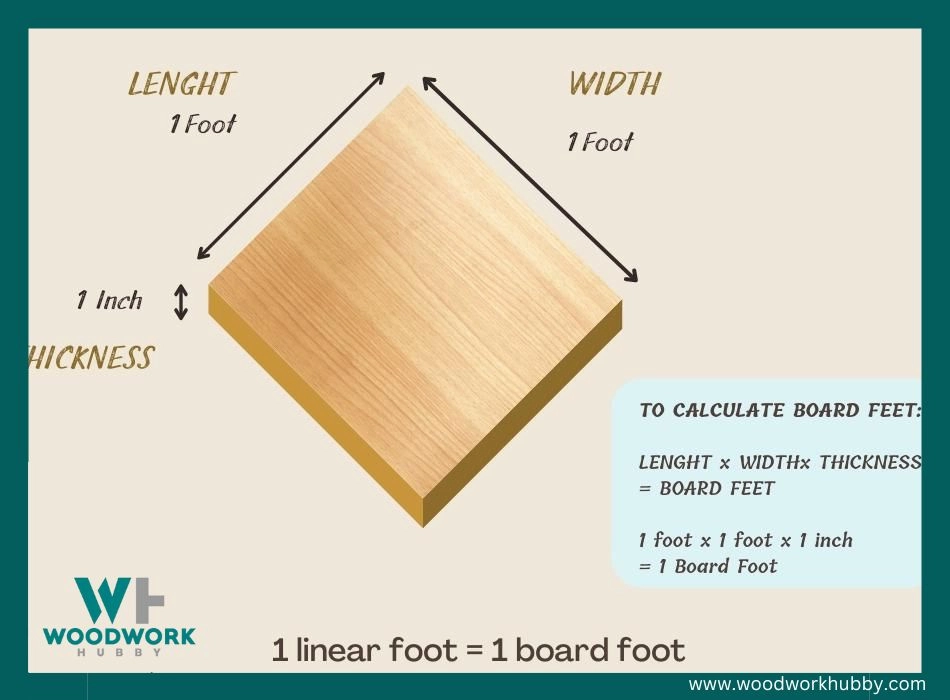
There can be one board foot in a linear foot, but only if the wood surface being measured is one inch thick and has the length and breadth of one foot each. This measurement requires many variables. It is easier to find how many linear feet are in a board foot, though.
There is a minimum of one linear foot in one board foot because one board foot is made up of one foot width, one-foot length, and one-inch thickness. In other words, a board foot is the volumetric measurement of a wood surface that is at least 1 linear foot long.
Board Feet vs. Cubic Feet
Since linear feet represent a 2-dimensional measurement and board feet measure the volume, it is often assumed that board feet are the same as cubic feet. They aren’t exactly the same, though.
Board feet and cubic feet are somewhat similar in that they both indicate volume. But cubic feet are measured in feet across the length, depth, and width of a surface, while board feet are measured across the length and breadth of an inch-thick surface.
Cubic feet are also far more versatile as a unit of measurement. They can be used to measure the volume of multiple items across different materials.
In contrast, board feet aren’t even used very often for wood that doesn’t fit the board measurement standard. The mathematical formula for board feet is not as consistent as that of cubic feet.
Here’s the cubic feet formula:
Length (feet) x Width (feet) x Depth (feet) = Volume (cubic feet).
Here’s the board feet formula:
Length (feet) x Width (inches) x Depth (inches) = 12 Board Feet
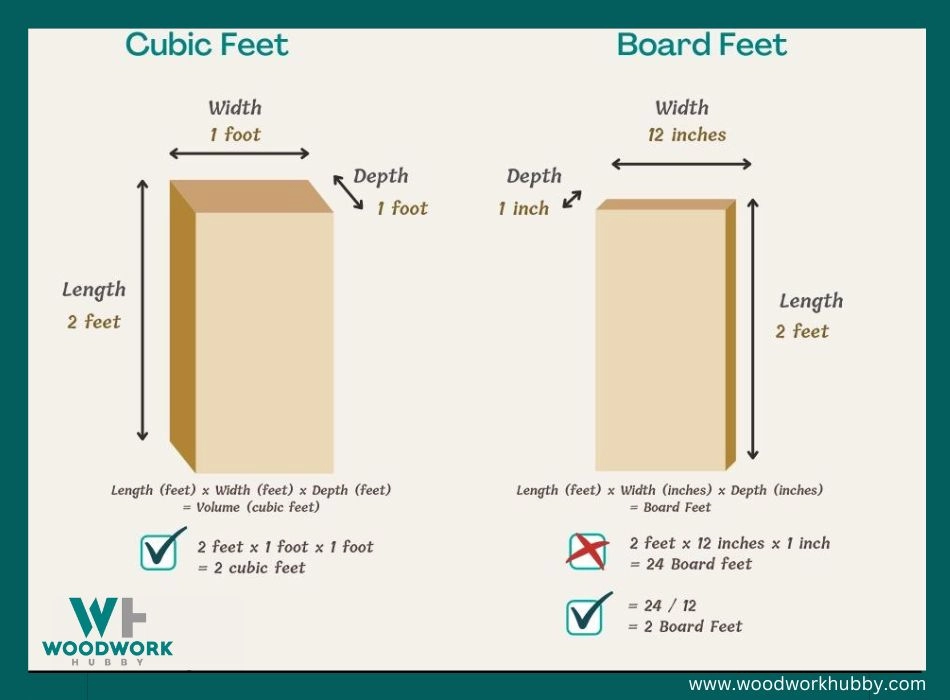
The actual formula results in 12x board feet because some of the dimensions are in inches. Division by 12 is needed because there are 12 inches in each foot. Even then, if the depth changes too much, the board feet calculation can be erroneous.
This can be very confusing, which is why the practical method for calculating board feet is quite different.
Here’s how board feet are actually calculated:
- Deal with wood boards that are actually 1-inch thick only
- Multiply the width and depth by feet
- You’ll get the board feet measurement
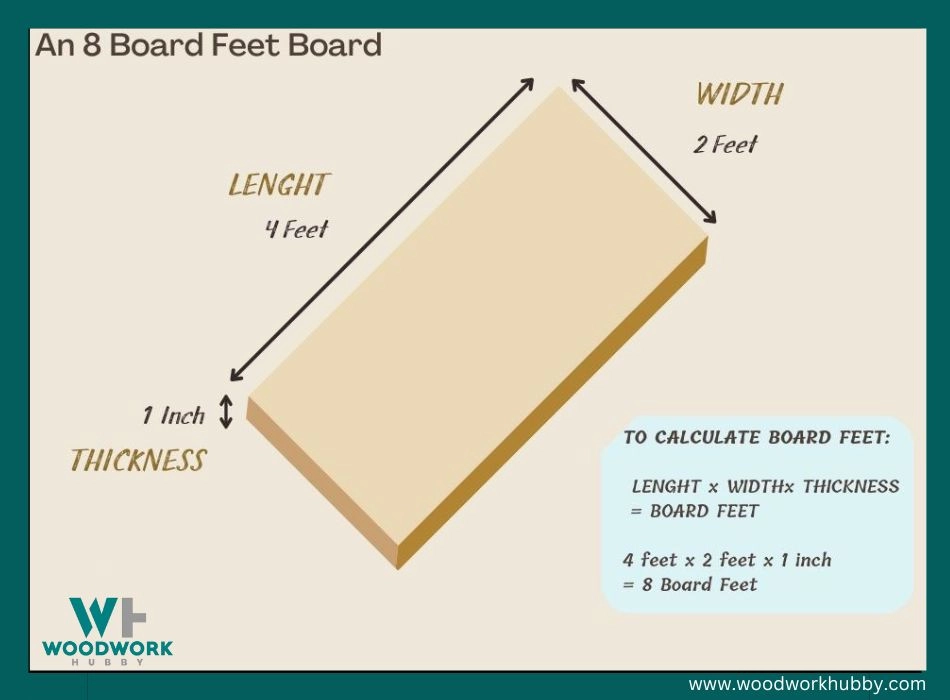
What Is the Difference Between a Board Foot and a Regular Foot?
A regular foot is 12 inches (30.48 centimeters) in length, while a board foot is an area in feet multiplied by the inches of thickness (which is often one). A board foot takes into account the length, width, and depth of a wood surface, while a regular foot helps measure these dimensions.
Let’s simplify this. If you are told about an apartment that’s 28 feet long (8.5 meters), will you buy it? If it is as broad as a theatre, you might. If it is as slim as a hallway, you might not. So the regular foot isn’t as helpful in apartment-hunting as a square foot (square meter).
When it comes to woodworking, isn’t regular feet are once again very limited. You cannot measure the rate of wood in feet. Board feet provide a solution that is now the industry standard for measuring the size of wood planks/boards.
A board foot can be measured by multiplying the length and the width of a wood surface in regular feet as long as the depth of said surface is one inch. It is often used in contexts where the wood planks are one-inch-thick, to begin with.
How Do You Figure Linear Board Feet?
If you want to get the linear feet measurement of a wood surface that you are familiar with the board feet measurement of, simply take the measurement of its length. The longest side of a board in feet is equal to its linear feet length.
Linear board feet is a phenomenon that requires two operating limits: the depth of the wood board must be one inch. And the width of it will be one foot. As long as these limits apply, the wood surface has the same linear and board feet reading. This is also the context where the board feet are most useful.
Lumber and Sizing FAQs
Should you buy wood in board foot or regular foot?
You should buy wood in regular square footage if you are purchasing wood from a big box store. But if you’re buying from a lumber yard, you will not be sold wood except in board feed.
How many board feet Is a log?
A log can range from 200 board feet to 800 board feet on average, depending on its width, height, and length. This doesn’t reflect the number of boards that can be created from the log but the volume of the log.
What are the two ways to calculate board feet?
You can calculate board feet using one of the following two formulae
- Length (ft) x Width (ft) x Depth (in) = Volume (Bdft)
- (Length (ft) x Width (in) x Depth (in) )/12 = Volume (Bdft)
Since depth is always in inches and width should ideally be in feet, you have to compensate for using the width’s inch measurement instead of its feet equivalent. And since 1 foot equals 12 inches (30.48 centimeters), you have to divide the answer by 12 to get the board feet rating.
Why Is Raw Lumber Not Sold in Feet?
It is hard to sell raw lumber in straight footage because the width of logs can vary. To avoid communicating erroneous information, raw lumber is sized using board footage.
Why Don’t Big Stores Use Board Footage?
Big boards sell wood planks that are 1-inch-thick, which makes their linear footage and area footage often the same as board footage. In many instances, the thickness of the material is mentioned separately.
Final Thoughts – Linear Foot vs. Board Foot
A linear foot is used to measure the length of a wood surface as well as the height, and short distances, Board foot is used to measure the volume and size of a wood board by multiplying the length and width in feet with thickness in inches.
Linear feet when calculated will lead to the volume in cubic feet. But in woodworking and lumber selection, if the orders are made in volume, the selling party doesn’t know whether what’s required is a long and lean board or a short and thick one. Board feet is used as it reflects the construction material’s standard requirements.

